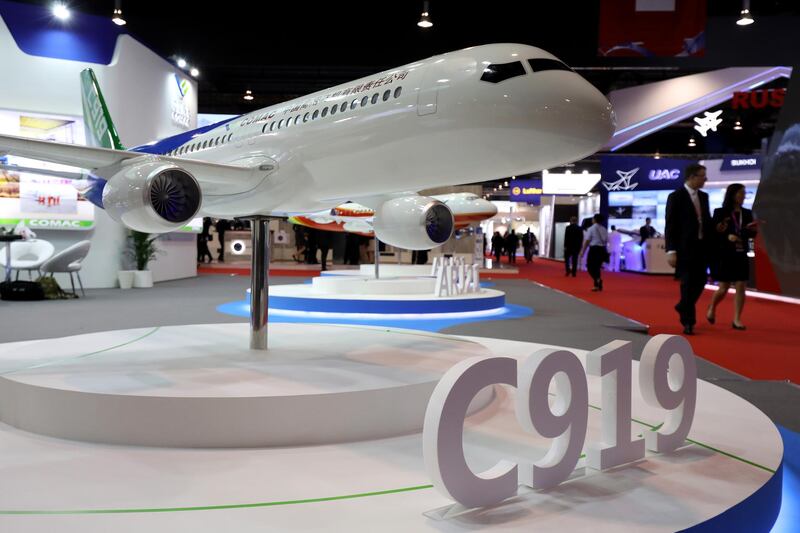China’s first airliner designed to compete with Airbus and Boeing is off to a slow start. After the fanfare surrounding the C919’s maiden flight in May, the single-aisle plane didn’t fly again for four months and the two test aircraft have only made about two dozen flights since, well below the normal schedule for a new commercial jet.
The dearth of flight time is a setback for a flagship project in President Xi Jinping’s plan to build a globally competitive aerospace industry and reduce China’s dependence on foreign aircraft makers.
“It just doesn’t bode well,” said Chad J R Ohlandt, a senior engineer with Santa Monica-based think tank RAND. “What should happen is the first two or three prototypes roll off the line and go through a series of tests - at least a few dozen.”
State-owned Commercial Aircraft Corp of China, or Comac, the manufacturer of the plane, would ground the first test aircraft for about two months to undergo modifications, deputy director of the C919 programme Wu Yue told Shanghai’s Dragon TV on January 23.
Part of the problem is that Comac’s home base is Shanghai Pudong International Airport, one of the busiest airports in the country. The company decided to transfer its first test aircraft in November to Yanliang in Xi’an, a city in western China. That should make for a better base to conduct tests, said Jin Wei, an aviation researcher at the China Center for Information Industry Development, a state-backed think tank in Beijing.
“Having a successful maiden flight doesn’t mean it will be a smooth ride all the way,” Mr Jin said. “They still need to make technical preparations and tweaks and this takes time.”
Comac pointed out that Airbus and Boeing, which both have dedicated testing airfields, have more experience in commissioning a new jet, while this is the Chinese manufacturer’s first narrow-body airliner. The company said the frequency of test flights has increased since the move to Xi’an.
"After the maiden flight in May, the aircraft has been undergoing a lot of checks and adjustments, not only for future test flights but for getting ready to move to another airport," a Comac spokesman said. “The testing for the C919 is progressing according to plan."
_______________
Read more:
China’s home-built jetliner makes maiden flight
All-new wide-body jetliner on cards as China and Russia unite
_______________
Normally, a company developing a new aircraft would follow the initial flight with many more tests, said George Ferguson, a Bloomberg Intelligence analyst. “Usually it doesn’t stutter-start.”
China is trying to break into a $1.1 trillion market that has been virtually owned by the duopoly of Chicago-based Boeing and Toulouse, France-based Airbus, since the formation of the European aerospace group more than four decades ago. The C919, which relies heavily on equipment and systems from North American and European suppliers, would compete in the lucrative medium-range market dominated by the ubiquitous Airbus’s A320 and Boeing’s 737.
Without international certification, the C919 plane couldn’t fly to Singapore for Asia’s biggest air show this week, where Comac and hundreds of other manufacturers and suppliers rub shoulders with Boeing and Airbus.
Comac has announced 785 orders for the C919, almost all from Chinese airlines.
Comac also has an order for the jet from GE Capital Aviation Services, an aircraft and engine leasing company. GE is one of C919’s contractors, supplying onboard maintenance and flight-data recording systems through a joint venture with Aviation Industry Corp of China. The plane’s engines come from CFM International, GE’s joint venture with Safran Aircraft Engines. Other suppliers include Honeywell International and United Technologies.
Comac is also trying to win customers for its smaller ARJ21 regional jet, which began commercial operation in 2016. So far, Comac has delivered just four of the planes, all to Chengdu Airlines, based in Sichuan. Comac is a major shareholder in Chengdu Airlines.
Comac “hasn’t delivered an aircraft to a customer they don’t own,” said Mr Ohlandt, who studies aerospace industrial policy in China and other countries. “The regional jet isn’t going anywhere.”
But China is playing a long game and, with the support of its government, Comac will eventually become a threat to the big two, according to the labour union that represents Boeing workers. Under the Made in China 2025 programme, launched by the Chinese government in 2015, aviation will be one of 10 new pillar industries to upgrade its economy.
China’s state-run ICBC Financial Leasing, the world’s fifth-largest aircraft leasing company, has promised to buy 100 C919s, while Shanghai-based launch customer China Eastern Airlines has said it will start negotiating the purchase of five C919s within a year of the maiden flight.
A Comac official said in Singapore Tuesday that the company expects mass production of the plane after 2021.
“New programmes take a long time,” said Owen Herrnstadt, director of trade and globalisation for the International Association of Machinists and Aerospace Workers, which argues the Chinese programme threatens American jobs. “It took the Europeans a long time with Airbus.”





